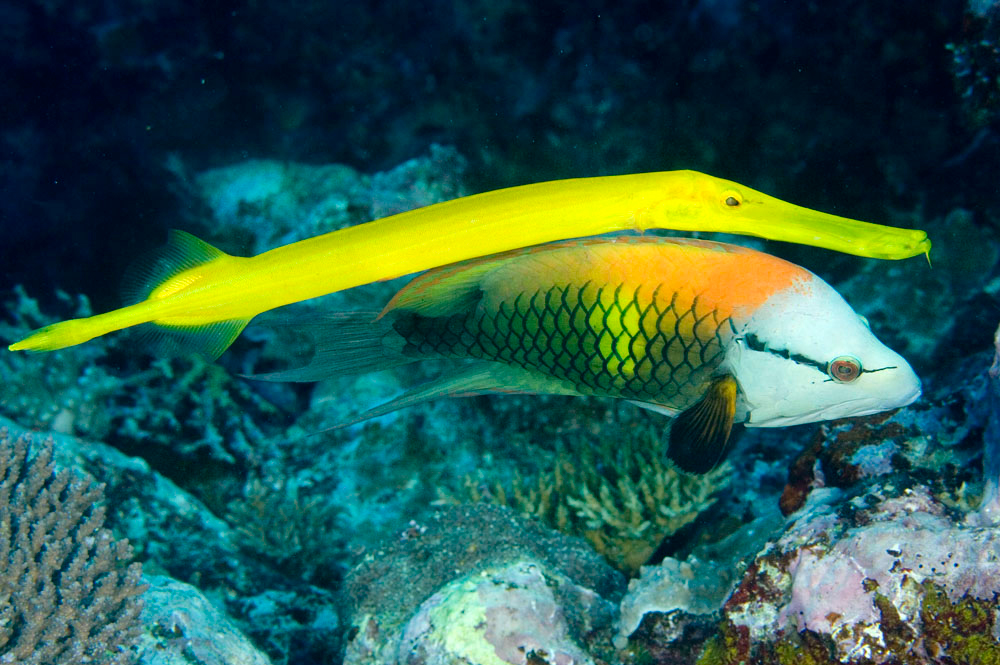- Classification
- ACTINOPTERYGII
- PERCIFORMES
- LABRIDAE
- Epibulus
- insidiator
Slingjaw Wrasse, Epibulus insidiator (Pallas 1770)

A male Slingjaw Wrasse, Epibulus insidiator, being shadowed by a Trumpetfish, Aulostomus chinensis, at Kadavu, Fiji. Source: Paddy Ryan / http://www.ryanphotographic.com/. License: All rights reserved
High speed footage showing the amazing protrusible jaws of the Slingjaw Wrasse.
Great underwater footage of a Slingjaw Wrasse feeding at 2 mins 50 secs into the video.
Slingjaw Wrasse, Epibulus insidiator (Pallas 1770)
More Info
|
Distribution |
Recorded from the Houtman Abrolhos to Rowley Shoals and Scott Reef, Western Australia, Ashmore Reef and Hibernia Reef, Timor Sea, and the Torres Strait islands to Lady Elliot Island, Queensland; also on reefs in the Coral Sea, and at Christmas Island and Cocos (Keeling) Islands, Indian Ocean. Elsewhere the species is widespread in the tropical, Indo-west-central Pacific. |
|
Fisheries |
Collected for food in many parts of its range, and for the aquarium trade, including in Australia. |
|
Remarks |
When catching prey, the highly protrusible jaws swing forward into a long tube to suck prey into the mouth. When not in use, the jaw apparatus is folded under the head. |
|
Similar Species |
The similar Latent Slingjaw Wrasse, Epibulus brevis, differs in the relatively drab coloration of the male, the presence of prominent black pigment on the pectoral fins of most females, slightly longer pectoral fins, and in attaining a smaller size. It lives in more protected inshore waters than E. insidiator. |
|
Species Citation |
Sparus insidiator Pallas, 1770. Spicilegia Zoologica 1 (fasc. 8): 41, pl. 5(1). Type locality: Java, Indonesia. |
|
Author |
Bray, D.J. 2016 |
Slingjaw Wrasse, Epibulus insidiator (Pallas 1770)
References
Allen, G.R. 1997. Marine Fishes of Tropical Australia and South-east Asia. Perth : Western Australian Museum 292 pp. 106 pls.
Allen, G.R., Steene, R.C. & Orchard, M. 2007. Fishes of Christmas Island. Christmas Island : Christmas Island Natural History Association 2 edn, 284 pp.
Allen, G.R. & Erdmann, M.V. 2012. Reef fishes of the East Indies. Perth : Tropical Reef Research 3 vols, 1260 pp.
Allen, G.R. & Smith-Vaniz, W.F. 1994. Fishes of Cocos (Keeling) Islands. Atoll Research Bulletin 412: 1-21.
Allen, G.R. & Swainston, R. 1988. The Marine Fishes of North-Western Australia. A field guide for anglers and divers. Perth, WA : Western Australian Museum vi 201 pp., 70 pls.
Carlson, B.A., Randall, J.E. & Dawson, M.N. 2008. A new species of Epibulus (Perciformes: Labridae) from the West Pacific. Copeia 2: 476-483.
Colin, P.L. & Bell, L.J. 1991. Aspects of the spawning of labrid and scarid fishes (Pisces: Labroidei) at Enewetak Atoll, Marshall Islands with notes on other families. Environmental Biology of Fishes 31(3): 229-260.
Donaldson, T.J. 1995. Courtship and spawning of nine species of wrasses (Labridae) from the western Pacific. Jap. J. Ichthyol. 42(3/4): 311-319.
Hutchins, J.B. 2001. Biodiversity of shallow reef fish assemblages in Western Australia using a rapid censusing technique. Records of the Western Australian Museum 20: 247-270.
Kuiter, R.H. 1996. Guide to Sea Fishes of Australia. A comprehensive reference for divers and fishermen. Sydney, NSW, Australia : New Holland Publishers xvii, 434 pp.
Pallas, P.S. 1770. Spicilegia Zoologica, quibus novae imprimus et obscurae animalium species iconibus, descriptionibus atque commentariis illustrantur. Berlin Tom. 1 Fasc. 8 54 pp. 5 pls.
Randall, J.E. 2005. Reef and shore fishes of the South Pacific. New Caledonia to Tahiti and the Pitcairn Islands. Honolulu : University of Hawaii Press 707 pp.
Randall, J.E., Allen, G.R. & Steene, R. 1990. Fishes of the Great Barrier Reef and Coral Sea. Bathurst : Crawford House Press 507 pp. figs.
Randall, J.E., Allen, G.R. & Steene, R. 1997. Fishes of the Great Barrier Reef and Coral Sea. Bathurst : Crawford House Press 557 pp. figs.
Roberston, D.R. & Foster, S.A. 1982. Off-reef migration of young adults of the labrid fish Epibulus insidiator. Copeia 1982(1): 227-229.
To, A., Liu, M., Craig, M. & Rocha, L. 2010. Epibulus insidiator. The IUCN Red List of Threatened Species. Version 2014.3.
Westneat, M.W. 2001. Labridae. pp. 3381-3467 in Carpenter, K.E. & Niem, T.H. (eds). The Living Marine Resources of the Western Central Pacific. FAO Species Identification Guide for Fisheries Purposes. Rome : FAO Vol. 6 pp. 3381-4218.







